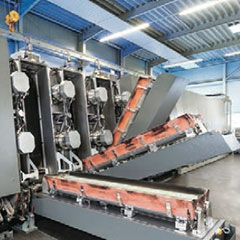SiOxNy layers serve different functions in coated layer stacks including: diffusion barrier, scratch protection, and refractive index tuning. We report on the increase of coating process stability and layer quality of SiOxNy deposited on large areas using reactive MF dual magnetron sputtering with 1.6m long cathodes oriented in a vertical geometry.
The process has been monitored using SOLAYER’s ‘SOL.rpc’ process control unit to detect the reactive species in situ and to provide an indirect indication of the level of target poisoning.
The effectiveness of the feedback control is evaluated in different modes such as target voltage and optical emission intensity signal tracking during reactive magnetron sputtering. These tests are carried out for different layer compositions and recipes using the in-line ‘V1600’ coater and process control unit ‘Sol.rpc’.
Introduction
The deposition of SiOxNy via reactive sputtering is commonly employed in large area coating applications. SiOxNy layers serve different functions in coated layer stacks including: diffusion barrier, scratch protection, and refractive index tuning.
Especially in PV thin film applications, SiON layers are used as a barrier layer between glass and the Mo back contact in CIGS technology, or in superstrate technologies to protect the front contact TCO layer from diffusion of sodium from the glass substrate.
In our study we see the increase of coating process stability and layer quality of SiOxNy deposited on large areas using MF dual magnetron sputtering on SOLAYER Gen5 coating equipment. The deposition was carried out using cathodes 1.6 m in length oriented in a vertical geometry.
The process was monitored with plasma emission spectroscopy using SOLAYER’s ‘SOL.rpc’ reactive process control unit to detect the reactive species in situ and provide an indirect indication of the level of target poisoning. The effectiveness of the feedback control is evaluated in different modes such as target voltage control and optical emission intensity signal tracking for different layer compositions and process recipes.
Conclusion
The in situ process control of SiOxNy reactive sputtering and its effect on material properties has been investigated on large area substrates. The uniformity of the deposition is very sensitive to the trim gas settings, which can have a pronounced effect on the film properties. Shorter response times and accurate process control are proven to be advantageous when regulating the deposition process with signals from plasma emission spectroscopy. We conclude that using simple target voltage to control the reactive sputtering process can not be recommended for production environment, since the usable process range of the sensor for voltage control is much narrower (<1 V) than that of the optical emission spectroscopy control by SOL.rpc.
For more detailed information about this topic, see also:
Andreas Panckow, Bradley Tinkham, Clement David, Pavel Prunici; SiOxNy Barrier Layers Deposited by Pulsed-DC Dual Magnetron sputtering, Proceedings of the SVC2014, Chicago 2014.
Andreas Panckow, Bradley Tinkham, Clement David and Pavel Prunici; High deposition rate reactive sputtering of SiOxNy layers using plasma emission monitoring and voltage feedback control; Proceedings of the ICCG10, Dresden 2014.
SOLAYER GmbH, Sachsenallee 28, 01723 Kesselsdorf, Germany
T +49 35204 269900 info@solayer.com www.solayer.com



























